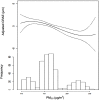Air Pollution and the microvasculature: a cross-sectional assessment of in vivo retinal images in the population-based multi-ethnic study of atherosclerosis (MESA)
- PMID: 21152417
- PMCID: PMC2994677
- DOI: 10.1371/journal.pmed.1000372
Air Pollution and the microvasculature: a cross-sectional assessment of in vivo retinal images in the population-based multi-ethnic study of atherosclerosis (MESA)
Abstract
Background: Long- and short-term exposures to air pollution, especially fine particulate matter (PM(2.5)), have been linked to cardiovascular morbidity and mortality. One hypothesized mechanism for these associations involves microvascular effects. Retinal photography provides a novel, in vivo approach to examine the association of air pollution with changes in the human microvasculature.
Methods and findings: Chronic and acute associations between residential air pollution concentrations and retinal vessel diameters, expressed as central retinal arteriolar equivalents (CRAE) and central retinal venular equivalents (CRVE), were examined using digital retinal images taken in Multi-Ethnic Study of Atherosclerosis (MESA) participants between 2002 and 2003. Study participants (46 to 87 years of age) were without clinical cardiovascular disease at the baseline examination (2000-2002). Long-term outdoor concentrations of PM(2.5) were estimated at each participant's home for the 2 years preceding the clinical exam using a spatio-temporal model. Short-term concentrations were assigned using outdoor measurements on the day preceding the clinical exam. Residential proximity to roadways was also used as an indicator of long-term traffic exposures. All associations were examined using linear regression models adjusted for subject-specific age, sex, race/ethnicity, education, income, smoking status, alcohol use, physical activity, body mass index, family history of cardiovascular disease, diabetes status, serum cholesterol, glucose, blood pressure, emphysema, C-reactive protein, medication use, and fellow vessel diameter. Short-term associations were further controlled for weather and seasonality. Among the 4,607 participants with complete data, CRAE were found to be narrower among persons residing in regions with increased long- and short-term levels of PM(2.5). These relationships were observed in a joint exposure model with -0.8 µm (95% confidence interval [CI] -1.1 to -0.5) and -0.4 µm (95% CI -0.8 to 0.1) decreases in CRAE per interquartile increases in long- (3 µg/m(3)) and short-term (9 µg/m(3)) PM(2.5) levels, respectively. These reductions in CRAE are equivalent to 7- and 3-year increases in age in the same cohort. Similarly, living near a major road was also associated with a -0.7 µm decrease (95% CI -1.4 to 0.1) in CRAE. Although the chronic association with CRAE was largely influenced by differences in exposure between cities, this relationship was generally robust to control for city-level covariates and no significant differences were observed between cities. Wider CRVE were associated with living in areas of higher PM(2.5) concentrations, but these findings were less robust and not supported by the presence of consistent acute associations with PM(2.5).
Conclusions: Residing in regions with higher air pollution concentrations and experiencing daily increases in air pollution were each associated with narrower retinal arteriolar diameters in older individuals. These findings support the hypothesis that important vascular phenomena are associated with small increases in short-term or long-term air pollution exposures, even at current exposure levels, and further corroborate reported associations between air pollution and the development and exacerbation of clinical cardiovascular disease. Please see later in the article for the Editors' Summary.
Conflict of interest statement
Several authors (SDA, AAS, MSO, RGB, DSS, PDS, and JDK) have received unrestricted grant funding or support on unrestricted grant funds to study related topics from the Environmental Protection Agency, National Institutes of Heath, and/or the Health Effects Institute.
Figures



References
-
- Brook RD, Rajagopalan S, Pope CA, Brook JR, Bhatnagar A, et al. Particulate matter air pollution and cardiovascular disease: an update to the scientific statement from the American Heart Association. Circulation. 2010;121:2331–2378. - PubMed
-
- Hoek G, Brunekreef B, Goldbohm S, Fischer P, van den Brandt PA. Association between mortality and indicators of traffic-related air pollution in the Netherlands: a cohort study. Lancet. 2002;360:1203–1209. - PubMed
-
- Maheswaran R, Elliott P. Stroke mortality associated with living near main roads in England and Wales - A geographical study. Stroke. 2003;34:2776–2780. - PubMed
-
- Adar SD, Kaufman JD. Cardiovascular disease and air pollutants: evaluating and improving epidemiological data implicating traffic exposure. Inhal Toxicol. 2007;19:135–149. - PubMed
Publication types
MeSH terms
Grants and funding
- ZIA EY000403/ImNIH/Intramural NIH HHS/United States
- N01-HC-95159/HC/NHLBI NIH HHS/United States
- N01 HC095159/HL/NHLBI NIH HHS/United States
- P30 ES007033/ES/NIEHS NIH HHS/United States
- N01-HC-95169/HC/NHLBI NIH HHS/United States
- N01 HC095165/HL/NHLBI NIH HHS/United States
- P50ES015915/ES/NIEHS NIH HHS/United States
- N01 HC095169/HL/NHLBI NIH HHS/United States
- HL69979/HL/NHLBI NIH HHS/United States
- Z99 EY999999/ImNIH/Intramural NIH HHS/United States
- R01ES016932/ES/NIEHS NIH HHS/United States
- K24 ES013195/ES/NIEHS NIH HHS/United States
- Z01 EY000403/ImNIH/Intramural NIH HHS/United States
- K24ES013195/ES/NIEHS NIH HHS/United States
- P30ES07033/ES/NIEHS NIH HHS/United States
- N01-HC-95165/HC/NHLBI NIH HHS/United States
- R01 ES016932/ES/NIEHS NIH HHS/United States
- P50 ES015915/ES/NIEHS NIH HHS/United States
- R01 HL069979/HL/NHLBI NIH HHS/United States
- EY000403/EY/NEI NIH HHS/United States
LinkOut - more resources
Full Text Sources
Medical
Molecular Biology Databases
Research Materials

